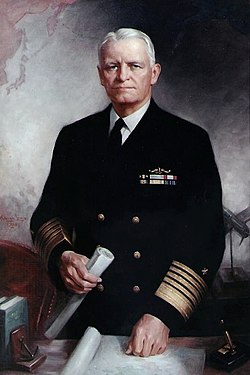Fleet Admiral Chester Nimitz (1885-1966)
 Chester William Nimitz, Sr. was a fleet admiral of the United States Navy. As Chief of Naval Operations 1945-47, Nimitz was instrumental in the approval and deployment of the Operation Highjump, the largest Antarctic expedition ever organized.
Chester William Nimitz, Sr. was a fleet admiral of the United States Navy. As Chief of Naval Operations 1945-47, Nimitz was instrumental in the approval and deployment of the Operation Highjump, the largest Antarctic expedition ever organized.
Naval Career and World War II
Nimitz was appointed to the Navy in 1901 and served in both World Wars. He played a major role in the naval history of World War II as Commander in Chief, U.S. Pacific Fleet and Commander in Chief, Pacific Ocean Areas, commanding Allied air, land, and sea forces. Nimitz was appointed Chief of (US) Naval operations in 1945, a position he held until 1947.
Operation Highjump (1946-1947)
After the war, the Navy was keen to retain public support and demonstrate its efficiency. This anxiety, coupled with the escalating cold war, created the opportunity to heavily expand on polar exploration. Admiral Richard E. Byrd, who had mounted several previous expeditions to the Antarctic, persuaded Nimitz and Secretary of the Navy James Forrestal into launching a huge naval expedition to the Antarctic. In 1946, Byrd was put in charge of the Antarctic Developments Project, planned for December 1946 – March 1947. The expedition, code named Operation Highjump, was and to this day still is, the largest Antarctic expedition ever organized.
Operation Highjump’s goals were primarily of a military nature. Instructions were for twelve ships and several thousand men to make their way to the Antarctic rim to:
- train personnel and test material in the frigid zones
- consolidate and extend American sovereignty over the largest practical area of the Antarctic continent
- determine the feasibility of establishing and maintaining bases in the Antarctic and to investigate possible base sites
- develop techniques for establishing and maintaining air bases on the ice and the applicability of such techniques to operations in Greenland
- amplify existing knowledge of hydrographic, geographic, geological, meteorological and electromagnetic conditions in the area
The armada arrived in the Ross Sea on December 31, 1946, and made aerial explorations of an area half the size of the United States, recording ten new mountain ranges. The major area covered was the eastern coastline of Antarctica from 150 degrees east to the Greenwich meridian.
Antarctic Legacy
The Nimitz Glacier was discovered by US Navy photographic flights of December 14-December 15, 1959 and was named after Fleet Admiral Nimitz, for his role in Operation Highjump. The glacier lies west of Mount Vinson and flows southeast between the Sentinel Range and Bastien Range to enter Minnesota Glacier, in the central Ellsworth Mountains. ALE flights follow the 40 nautical mile (74 km; 46 mi) long glacier as they approach Mount Vinson.